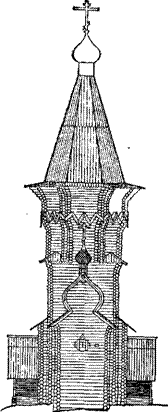
Russian art is closely associated with folk art. This is manifested in the penetration of the motives of folk art in professional art. Russian art has created artistic values of world importance, which is determined by high humanistic ideals permeating the works of the best Russian artists.
The Russian people were excellent builders, masterfully owning such material as wood, which our land is rich in. Everything was made of wood — from the temple to the spoon: huts, noblemen’s mansions, religious buildings, etc. Already in ancient times, a type of peasant dwelling was formed, which is a simple structure with a gable roof. The type of building found by generations formed the basis of wooden and stone architecture that has developed over the centuries.
The development of artistic woodworking is closely related to the general development of Russian art and architecture. There are few authentic monuments of the art of wood processing, therefore they are studied from chronicles, literary sources, folklore, images in painting and miniature, evidence of foreigners visiting Russia, and also attract monuments of folk art of a later time, which have preserved traditional forms under the influence of persistent social -economic, domestic and artistic factors.
The art of artistic woodworking in Russian art is a unique phenomenon, which gave the world magnificent architectural monuments, intricate carvings, and beautiful household utensils. In Russia, wood has long been the most common and favorite material. Russian craftsmen used only an ax to cut huts, chambers, cathedrals, and made household and household items with elaborate carvings.
The art of wood processing dates back to the art of the ancient Slavs who settled in the first millennium AD e. along the banks of the Dnieper, the Volga, the Don, Lake Ilmen. On the walls of the Slavic sanctuaries were placed images of people, birds, animals, which, according to the testimony of the chronicles, seemed to “have life”. The influence of Slavic, still pagan, figurativeness was felt in the art of woodworking in the following centuries. Pagan religious representations of the ancient Slavs led to widespread use, especially in decorative and applied arts, of pictorial motifs (fantastic animals, female figures next to horses, etc.) associated with mythology. The spread of wood as a building material was promoted by such valuable qualities as good thermal insulation, water resistance, low density, beautiful natural color and a variety of texture patterns. Residential buildings and outbuildings were built from wood (barns, barns, baths, mills). Wooden were fortifications, city walls, bridges, temples. Boats, planes, ships, sleds, carts, carriages, tools for agriculture and household work (spinning wheels, spindles), dishes (spoons, ladles, salt shakers, bowls and cups, buckets, tubs) were made from wood.
The people, knowing perfectly all the valuable qualities of the tree, skillfully used all its parts in the household. So, birch bark, which does not absorb moisture, covered the roofs, sewed covers for storing carpentry and carpentry tools from strips of birch bark to make it rust-proof, made all kinds of food storing. Famous Novgorod letters are written on birch bark. Capo-root (flowing on the roots of deciduous trees), with its hardness, elasticity and rare beauty of the natural texture pattern, produced thin-walled dishes. From a well-bending willow weaving large and small baskets, different in purpose and shape, cradles.
There were various ways of artistic wood processing. But the most common was carving. The carvings were decorated with architectural structures, furniture, various crafts and household items. Wood carving was used in other crafts. When finishing fabrics by tamping, i.e. by hand printing ink over the fabric, manners were used — wooden boards with a carved pattern. Ceramic tiles with a relief pattern were made using wooden forms. Wooden printed boards with carving used to make gingerbread. Various peasant spinning wheels decorated with carvings or carvings with painting are widely known.
Along with carvings, other methods (painting, mosaic) were used for the artistic finishing of wood, which were sometimes combined.
Russian masters of artistic woodworking had an inexhaustible imagination, an excellent knowledge of the material, a sense of beauty, which allowed them in every work, from the magnificent temple (Fig. 1) to a wooden spoon, to create authentic works of art.

Fig. 1. Wooden Assumption Church in Kandopoga (1774)
Что бы оставить комментарий войдите
Комментарии (0)